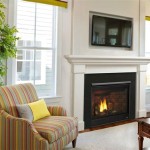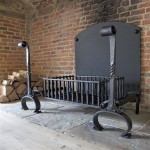Decorative Fireplace Log Grates: Functionality and Aesthetics
Decorative fireplace log grates are essential components of a traditional wood-burning fireplace, serving both functional and aesthetic purposes. They elevate the logs, allowing for better airflow and a more efficient burn, while also contributing to the overall visual appeal of the fireplace. The design, material, and size of a log grate can significantly impact the performance and style of the fireplace. This article will explore the various aspects of decorative fireplace log grates, delving into their benefits, types, selection criteria, and maintenance, providing a comprehensive understanding for homeowners and fireplace enthusiasts.
Enhancing Fireplace Efficiency and Aesthetics
The primary function of a log grate is to improve the efficiency of a wood-burning fireplace. By raising the logs off the hearth, the grate allows air to circulate underneath and around the wood. This increased airflow facilitates more complete combustion, resulting in a hotter, brighter, and more efficient fire. The embers fall through the grate, creating a bed of coals that radiate heat upwards, improving the overall heat output of the fireplace. Without a grate, the logs would sit directly on the hearth, restricting airflow and leading to a smoldering fire that produces more smoke and less heat. Moreover, log grates contribute to fireplace safety by containing the logs and preventing them from rolling out onto the hearth.
Beyond functionality, log grates are also decorative elements that enhance the visual appeal of a fireplace. They are available in a wide range of styles, finishes, and materials, allowing homeowners to choose a grate that complements their home décor and personal taste. From simple, minimalist designs to ornate, handcrafted pieces, log grates can add a touch of elegance and sophistication to any fireplace. The visual impact of a well-chosen log grate can transform a fireplace from a mere source of heat into a captivating focal point of the room.
Furthermore, a quality log grate can extend the lifespan of the fireplace hearth. By preventing direct contact between burning logs and the hearth, the grate minimizes the risk of damage from heat and embers. This protective barrier helps to preserve the integrity of the hearth material, whether it's brick, stone, or tile, reducing the need for costly repairs or replacements.
Types of Decorative Fireplace Log Grates
Log grates are available in a variety of designs and materials, each with its own unique characteristics and benefits. Understanding the different types of log grates is essential for selecting the right one for a particular fireplace and aesthetic preference.
Cast Iron Log Grates: Cast iron log grates are known for their durability and heat retention capabilities. Cast iron is a robust material that can withstand high temperatures and repeated use without warping or cracking. These grates often feature intricate designs and patterns, adding a touch of traditional elegance to the fireplace. They are heavier compared to other types, providing stability and preventing the logs from shifting during burning. The heat retention properties of cast iron also contribute to a more consistent and prolonged heat output from the fire.
Steel Log Grates: Steel log grates offer a more modern and minimalist aesthetic. They are typically constructed from heavy-duty steel bars that are welded together to form a sturdy and functional grate. Steel grates are lighter than cast iron grates, making them easier to maneuver and clean. They are also more resistant to rust and corrosion, especially when treated with a protective coating. Steel log grates are a popular choice for contemporary homes with a focus on clean lines and simple designs.
Wrought Iron Log Grates: Wrought iron log grates combine durability with decorative appeal. Wrought iron is a malleable material that can be shaped into intricate designs and patterns. These grates often feature hand-forged details, adding a touch of craftsmanship and artistry to the fireplace. Wrought iron log grates are strong and durable, capable of withstanding high temperatures and heavy loads. They are a popular choice for homeowners seeking a unique and visually appealing grate that complements a traditional or rustic décor.
Tube Log Grates: Tube log grates are designed to maximize airflow and promote efficient combustion. These grates feature hollow steel tubes that allow air to circulate directly through the logs, resulting in a hotter and brighter fire. Tube log grates are particularly effective for burning smaller or less dense types of wood. They are a popular choice for homeowners who prioritize efficiency and heat output over aesthetics.
Arched Log Grates: Arched log grates, as the name suggests, feature an arched design that provides additional support for the logs and allows for better airflow. The arch shape helps to distribute the weight of the logs evenly across the grate, preventing sagging or warping. Arched log grates are particularly well-suited for larger fireplaces that accommodate longer logs. They offer a combination of functionality and aesthetic appeal, adding a touch of elegance to the fireplace.
Selecting the Right Log Grate: Key Considerations
Choosing the right log grate involves several factors, including the size of the fireplace, the type of wood being burned, and the desired aesthetic. Careful consideration of these factors will ensure that the selected grate performs optimally and complements the overall design of the fireplace.
Fireplace Size: The size of the fireplace is the most important factor to consider when selecting a log grate. The grate should be smaller than the firebox to allow for proper airflow and prevent the logs from touching the sides of the fireplace. Measure the width, depth, and height of the firebox before purchasing a grate. As a general rule, the grate should be at least 6 inches shorter than the width of the firebox and deep enough to accommodate the length of the logs being burned. A grate that is too large will restrict airflow and prevent the fire from burning efficiently.
Wood Type: The type of wood being burned can also influence the choice of log grate. Hardwoods, such as oak and maple, require more airflow than softwoods, such as pine and fir. If burning hardwoods frequently, consider a grate with wider spacing between the bars to allow for better airflow. Tube log grates are also a good option for burning hardwoods, as they provide direct airflow through the logs. Softwoods tend to burn faster and produce more embers, so a grate with smaller spacing between the bars may be preferable to prevent embers from falling through and onto the hearth.
Material and Durability: The material and durability of the log grate are crucial factors to consider, especially if the fireplace is used frequently. Cast iron and steel are the most common materials used for log grates. Cast iron is known for its durability and heat retention, while steel is more resistant to rust and corrosion. Choose a grate made from heavy-duty materials that can withstand high temperatures and repeated use without warping or cracking. A well-constructed log grate should last for many years with proper care and maintenance.
Aesthetic Appeal: While functionality is paramount, the aesthetic appeal of the log grate should also be considered. The grate should complement the overall design of the fireplace and the surrounding room. Choose a style and finish that reflects personal taste and enhances the visual appeal of the fireplace. Consider the architectural style of the home and select a grate that is consistent with that style. For example, a traditional home might benefit from a cast iron or wrought iron grate with intricate details, while a modern home might be better suited for a sleek steel grate with clean lines.
Height and Clearance: The height and clearance of the log grate are important considerations for ensuring proper airflow and efficient combustion. The grate should be high enough to allow air to circulate freely underneath the logs, but not so high that it reduces the heat output of the fire. A clearance of 3 to 4 inches between the bottom of the logs and the hearth is generally recommended. Also, ensure that the grate does not interfere with the operation of any fireplace doors or screens.
Maintenance and Cleaning: Regular maintenance and cleaning are essential for prolonging the lifespan of a log grate and maintaining its performance. Remove ashes and debris from the grate regularly to prevent buildup and ensure proper airflow. Use a wire brush to scrub away any creosote or soot that may accumulate on the grate. Inspect the grate regularly for signs of wear and tear, such as cracks or warping. Repair or replace the grate as needed to ensure safe and efficient operation. Consider applying a heat-resistant paint or coating to the grate to protect it from rust and corrosion.

White Mountain Hearth Dcg24bl Decorative Fireplace Grate Matte Black

Costway 25 In Fireplace Log Grate Heavy Duty Steel Firewood Burning Rack Holder H9i 10n282 M The Home Depot

Singlyfire Fireplace Grate 30 Inch Heavy Duty Firewood Stove Log Holder Cast Iron Wrought Wood Burning Rack For Indoor Outdoor Chimney Com

Amagabeli Fireplace Log Grate 24 Inch Wide Heavy Duty Solid Steel Indoor Chimney Hearth 3 4 Bar Fire Grates For Outdoor Kindling Tools Pit Wrought Iron Wood Stove Firewood Burning Rack Holder Black

Costway 18 In Fireplace Log Grate Heavy Duty Steel Firewood Burning Rack Holder H9i 10n282 S The Home Depot

Singlyfire Fireplace Grate 30 Inch Heavy Duty Firewood Stove Log Holder Cast Iron Wrought Wood Burning Rack For Indoor Outdoor Chimney Com
.jpg?strip=all)
20 Best Fireplace Accessories And Tools Architectural Digest

Fireplace Grates Convert Traditional Fireplaces Ecosmart Fire

10 Tips For Choosing A Fireplace Grate Or Andirons

Uniflame Zero Clearance Cast Iron Stack Grate
Related Posts








